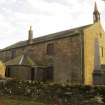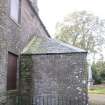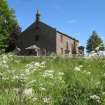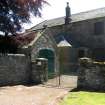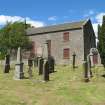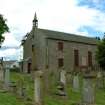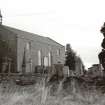Ordnance Survey licence number AC0000807262. All rights reserved. © Copyright and database right 2024.
Useful Links
- Canmore:
- TEALING PARISH CHURCH AND CHURCHYARD
- Historic Scotland:
- HS Reference No 17450
General Details and Location
Category
AT RISK
Name of Building
Tealing Parish Church (Former)
Other Name(s)
Address
Kirkton of Tealing
Locality
Postcode
Planning Authority
Divisional Area
Reference No
877
Listing Category
A
OS Grid Ref
NO 40350 37943
Location Type
Rural Settlement
HS Reference No
17450
Description
Plain rectangular-plan aisleless hall-church. Rubble built, ashlar dressings, harled at E gable, grey slate roof. Square-headed margined windows, timber top-hopper frames with small rectangular leaded panes. Coped skews with skew blocks.
Conveyed by Church of Scotland General Trustees to the Tealing Kirk Heritage Centre in 1986. The first church at Tealing was probably established by St Boniface in the late 7th century although the exact site is not known. The Rev John Glas, founder of the Glasite Sect was minister of Tealing 1719-28 and promulgated his secterian teaching here. The present building, although severely plain is of great interest on account of the various sculpted stones incorporated within the fabric, the prime factor for its Category A listing. The tombstone of Ingram of Kethenys is particularly rare, it being (according to Jervise) on of the oldest inscriptions in the Scottish vernacular. The memorial to John Ramsay is also a notable Renaissance style monument. The memorial slab to the Scrymsoure Fothringhams was made by Alexander Macdonald, Field and Co, for the architects Charles Edward and Thomas Saunders Robertson, 1867. There are various hinges and hooks affixed to the external walls adjacent to the windows suggesting that there were once shutters. Central heating was first installed by Alexander Johnston in 1895. (Historic Environment Scotland List Entry)
Conveyed by Church of Scotland General Trustees to the Tealing Kirk Heritage Centre in 1986. The first church at Tealing was probably established by St Boniface in the late 7th century although the exact site is not known. The Rev John Glas, founder of the Glasite Sect was minister of Tealing 1719-28 and promulgated his secterian teaching here. The present building, although severely plain is of great interest on account of the various sculpted stones incorporated within the fabric, the prime factor for its Category A listing. The tombstone of Ingram of Kethenys is particularly rare, it being (according to Jervise) on of the oldest inscriptions in the Scottish vernacular. The memorial to John Ramsay is also a notable Renaissance style monument. The memorial slab to the Scrymsoure Fothringhams was made by Alexander Macdonald, Field and Co, for the architects Charles Edward and Thomas Saunders Robertson, 1867. There are various hinges and hooks affixed to the external walls adjacent to the windows suggesting that there were once shutters. Central heating was first installed by Alexander Johnston in 1895. (Historic Environment Scotland List Entry)
Building Dates
1806; 1895
Architects
Unknown, Alexander Johnston (alterations)
Category of Risk and Development History
Condition
Fair
Category of Risk
Moderate
Exemptions to State of Risk
Field Visits
December 1991, October 1994, 18/06/2008, 12/06/2009, 29/10/2012, 21/6/2016
Development History
1986: The Church of Scotland General Trustees make the church over to the Tealing Kirk Heritage Centre Trust for potential use as an interpretation centre. December 1991: External inspection reveals the church to remain unused and deteriorating. October 1994: External inspection reveals the church to be in a serious state of disrepair. November 1998: The Tealing Kirk Heritage Centre Trust is voluntarily dissolved, and the church passes to the Queen and Lord Treasurer's Remembrancer. The Crown subsequently disclaims any interest in the building and no other parties move to take title, leaving it effectively ownerless. March 2000: Angus Council boards up the building. November 2003: Local planners report no change. September 2004: Local planners report that the church is without ownership. An architect has recently expressed an interest in converting the church to residential use, and the Council would be prepared to assume and transfer ownership. May 2005: Local planners report that they are unaware of any change.
June 2008: External inspection finds the church remains vacant. There are many slipped or broken slates and the rainwater goods are conjested which could lead to accelerated decay through water penetration. To the south side of the church, the burial enclosure die-walls show signs of movement due to tree growth. Local planners report that the building may have been purchased around 2006.
March 2009: A member of the the public advises that the property was purchased in March 2000 by James Eian Prentice and John Davidson (one of whom has since died) with a consideration for Certain Good and Onerous Causes recorded by the Registers of Scotland. The building has been lying vacant and deteriorating since the council boarded it up the very same month it was sold.
June 2009: External inspection finds the building disused with opendings boarded over. It is generally in good condition.
29 October 2012: External inspection finds no significant change from the previous site visit although the roof and rainwater goods ahve all deteriorated.
9 September 2015: A member of the public notes an increase in slipped roof slates on the building.
21 June 2016: External inspection finds a tarpaulin is now covering the North pitch of the roof and some clearance works appear to have taken place. Otherwise, the building remains in much the same condition as seen previously.
28 February 2022: Listed building consent (20/00448/LBC) and planning permission (20/00449/FULL) conditionally approved for alterations to building to facilitate use as a dwellinghouse.
Guides to Development
Conservation Area
Planning Authority Contact
PAC Telephone Number
03452 777 778
Availability
Current Availability
Unknown
Appointed Agents
Price
Occupancy
Vacant
Occupancy Type
N/A
Present/Former Uses
Name of Owners
Unverified see FAQ on ascertaining ownership
Type of Ownership
Unknown
Information Services
Additional Contacts/Information Source
Bibliography
Hay (1957), pp239, 246; Jervise (1875-1879), vol. II; Warden (1880-1885), vol. V, pp210-213; Proceedings of the Society of Antiquaries in Scotland, (30) and (45), 1895-1896 and 1910-1911, p47 and pp420-427; Tayside and Fife Archaeological Journal, (4), 1998, pp166-169; Transactions of the Scottish Ecclesiological Society 1909-1912, vol. III, p95.
Online Resources
Classification
Churches and Chapels
Original Entry Date
13-DEC-91
Date of Last Edit
10/08/2016





